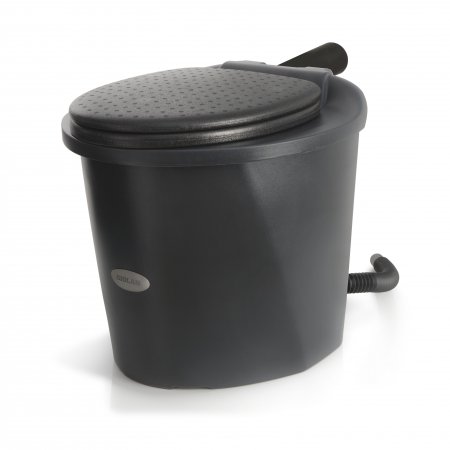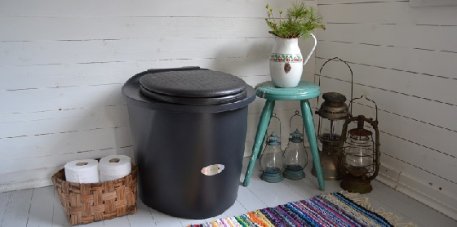Install the Biolan Simplett at a level position on the floor. When deciding where to locate the unit, take into account the space required for its ventilation and liquid removal arrangements, as
well as its use and maintenance. The unit must be placed so that the top cover of the tank can be opened wide enough to enable easy emptying.
Year-round use of the toilet
If you install the Simplett toilet in a warm space, you may use it all year round. Then, its ventilation and liquid removal systems must be insulated in cold spaces, and the liquid removal pipe must be provided with a sufficient gradient to prevent the liquid from freezing in the pipe. If the liquid is collected in a canister, the canister must be emptied in the autumn in order to prevent it from breaking due to the frost. A toilet located in a cold space can be used occasionally during the winter. The Simplett is manufactured of frost-proof materials, so freezing does not damage it.
Ventilation
Installing the horizontal ventilation pipe
Install the horizontal ventilation pipe in the unit. Observe that the end of the pipe must extend to above the inner receptacle to enable the water, that may possibly condense, to flow into the inner receptacle.
Leading the ventilation pipe through the rear wall
Leading the ventilation pipe through the rear wall. Make a lead-trough hole of at least Ø 75 mm, according to the dimension drawing for the horizontal ventilation pipe. The hole to be made in the wall must be located slightly higher than the hole in the unit to prevent the condensed water from remaining in the pipe. Cut the horizontal ventilation pipe to a suitable length so that the angular union used will be connected to the vertical ventilation pipe with a curve as gentle as possible. Make sure that the pipe will be located inside the toilet. Extend the horizontal ventilation pipe to above the roof ridge, using a sewer pipe of Ø 75 mm. The Ventilation Pipe Package, which is designed for the purpose, is available as an accessory from the dealers. A suitable pipe can also be obtained from HVAC stores and well-appointed hardware stores. We recommend using a rounded angular union. Any extra bends in the pipe will impede natural ventilation, and may cause odour problems. If you want, you can improve the ventilation by using the Biolan Wind Fan.
Ventilation pipe in the toilet space
The ventilation pipe can also be routed up through the roof inside the toilet space following the instructions above. The lead-though in the roof can be sealed, for example, using the lead-through set for the roof. The lead-throughs are available as accessories from hardware stores.
Liquid removal
Installing the liquid funnel and the liquid pipe
Connect the liquid funnel (part 8) to the liquid pipe (part 7), and install the funnel in the bracket (part 6)(Fig. 3) inside the unit. Route the liquid removal pipe by the inner receptacle through the hole in the rear part of the unit. The pipe is flexible, and its length can be adjusted by pulling at the ends. If the space is not provided with a sewer, make a hole of at least Ø 43 mm in the rear wall or in the floor for the liquid removal pipe (part 7)(Fig. 4).
Draining the liquid
Route the liquid pipe into a closed canister, tank or the sewer system. Observe, when dimensioning and selecting the location for the liquid tank, that the amount of urine excreted per person and day is about 1–1.5 litres. During installation of the liquid pipe, remember to provide a sufficient gradient (2–3 cm/m) to enable the liquid to flow down without obstruction. Therefore, the hole to be made in the wall must be located lower than the hole in the unit. If you want, you can lay the canister on its side or bury it in the ground.
You can ask your dealer to order the Canister Package and parts for extending the liquid pipe. The pipe can also be extended using sewer pipe parts of Ø 32 mm. We recommend using connecting
sleeves in the joints.








